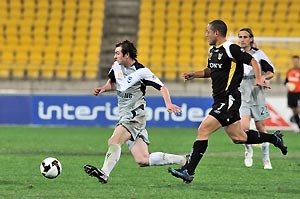
Melbourne Victory's Sebastian Ryall out runs Wellington Phoenix's Leo Bertos during the A-League pre-season final at Westpac Stadium in Wellington, New Zealand, Wednesday, Aug. 6, 2008. AAP Image/NZPA, Ross Setford
We’ve all heard the argument against A-League fixtures clashing with FIFA dates and this weekend is a case in point. The FFA admits they’ll review the situation at season’s end, but with a congested fixture list next season, it’ll be a tough decision.
The 2010-2011 Hyundai A-League campaign will see eleven teams compete for the ‘silver toilet seat’, with a decision not yet made on the format for the next season.
Many expect the FFA to go with a 33-round season but that hasn’t been decided yet, with 22 rounds still an option.
Creating all the drama is the fact the FFA remain reluctant about seeing the A-League overlap with the AFL and NRL competitions, which both kick off in early-to-mid March.
And considering the A-League’s attendance figure woes during those rival codes’ respective finals series, it is understandable.
But with the introduction of Melbourne Heart next season, under a 33-round system, there will be an extra 6 rounds of football to be played.
That will be hard to fit into the FFA’s preferred A-League window from August to early-March.
Alternately, the A-League could simply run for 22 rounds, with every team playing each other twice, before the top six finals.
It would easily fit into the calendar, but perhaps 20 games wouldn’t suffice for the clubs and the fans, who will get either 13 or 14 home games this season compared to a meager 10 under that format.
Confusing the matter more is the fact the 2011 AFC Asian Cup in Qatar (which Australia should compete in) will be played during the A-League season, during the Middle East winter from January 7-29.
As this weekend’s international fixtures showed, the A-League is affected by FIFA dates, and such a clash in 2011 would be detrimental to the competition.
For example, Sunday’s South-East Queensland derby between Brisbane Roar and Gold Coast United was without three of its main drawcards, in Socceroos pair Jason Culina and Craig Moore along with All-Whites international Shane Smeltz.
It’s easy to argue those who attended the match at Suncorp may have felt a bit short-changed without those quality players on display.
And you could argue the discrepancy of the derby crowds from Round 1’s figure of 19,902 compared to this weekend’s 8,882, could in some ways be attributed to the absence of the big names.
Indeed, when the Asian Cup rolls around in January 2011, if the A-League loses a whole host of stars for 3-4 weeks, fans will feel short-changed, as well as those clubs who may subsequently drop results due to the loss of their best players.
And it is quite realistic to believe there will be a large A-League contingent in the Socceroos squad in 2011, considering the potential retirement of several European-based veteran Socceroos after the 2010 World Cup.
Add to that the fact that the Asian Cup won’t run during a FIFA break and there could be club-versus-country problems with some European-based players, which may force Australia to look at A-League options.
That’s not to say it will happen, but as the African Cup of Nations shows sometimes there’s the odd problem or two if injury clouds come into it.
Also the problem won’t be the Asian Cup alone, with five FIFA international breaks set to interrupt the 2010-2011 A-League season.
And there are plenty of international players floating around the A-League these days, as the re-scheduling of Wellington-Newcastle this weekend showed with the Phoenix minus six All-Whites players plus Malta’s Manny Muscat.
And as the A-League grows, we should be hoping it gets more capable of attracting international stars, rather than hoping they don’t get selected like Melbourne’s Costa Rican midfielder Carlos Hernandez this week.
The simple solution is to postpone and re-schedule matches when those situations arise, like the FFA did with Wellington this weekend. But how often can that happen before it totally disrupts the league, especially considering the 3-week Asian Cup and the 5 FIFA breaks scheduled during next season?
The Phoenix will now face the Jets on the first Wednesday of November and more midweek matches aren’t out of the question looking ahead.
Buckley said a few months back, “We think there’s an opportunity for it (midweek football), we haven’t determined that’s the direction we’ll go but it’s certainly on the drawing board.
“I think television would welcome it – if you look at any TV sports schedule during the course of the week, there’s not a lot of genuine competition during the summer months.”
During December and January this season there will be a number of Wednesday matches which will give the FFA a rough idea on the concept’s viability.
But the FFA showed by not re-scheduling the Brisbane-Gold Coast match this weekend that they are not willing to change too many fixtures, as unfair as that was on the fans.
Fundamentally, though, the whole problem lay with the FFA’s reluctance to schedule the A-League alongside the AFL and NRL, and as this season’s crowd figures show, there’s reason to be cautious.
Next season will offer up an increasingly congested fixture list for the FFA and how they handle it will take plenty of consideration.
And they must not forget those who hand over their money to watch the A-League every week, because denying them the opportunity to witness the best players because of international clashes is far from ideal.
But there are clearly no easy solutions here, so you’d think something’s got to give.





























































































